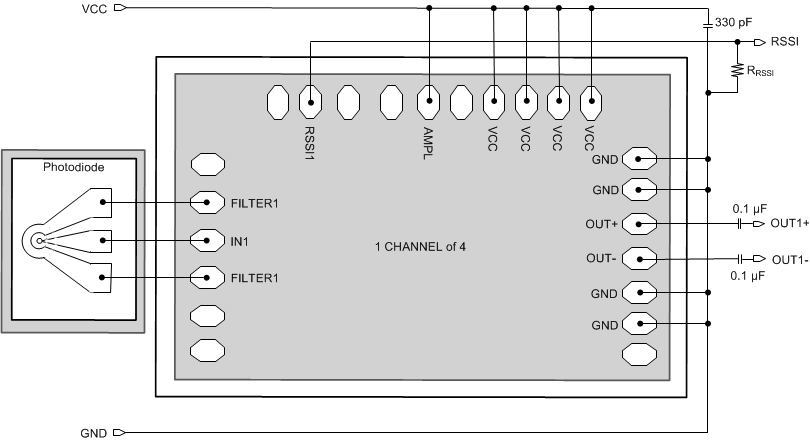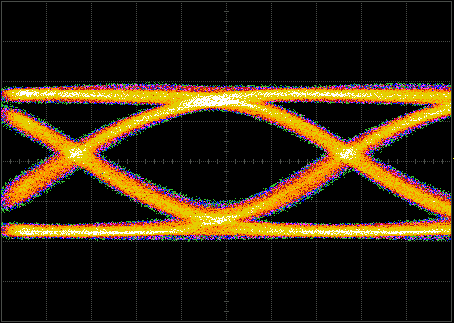ZHCSGK6 July 2017 ONET2804TLP
PRODUCTION DATA.
- 1 特性
- 2 应用
- 3 说明
- 4 修订历史记录
- 5 Pin Configuration and Functions
- 6 Specifications
-
7 Detailed Description
- 7.1 Overview
- 7.2 Functional Block Diagram
- 7.3 Feature Description
- 7.4 Device Functional Modes
- 7.5 Programming
- 7.6
Register Maps
- 7.6.1 Register Descriptions
- 7.6.2 Register 0: Control Settings (address = 00h) [reset = 0h]
- 7.6.3 Register 1: Amplitude and Rate for Channel 1 (address = 01h) [reset = 0h]
- 7.6.4 Register 2: Threshold and Gain for Channel 1 (address = 02h) [reset = 0h]
- 7.6.5 Register 7: Amplitude and Rate for Channel 2 (address = 07h) [reset = 0h]
- 7.6.6 Register 8: Threshold and Gain for Channel 1 (address = 08h) [reset = 0h]
- 7.6.7 Register 13: Amplitude and Rate for Channel 3 (address = 0Dh) [reset = 0h]
- 7.6.8 Register 14: Threshold and Gain for Channel 3 (address = 0Eh) [reset = 0h]
- 7.6.9 Register 19: Amplitude and Rate for Channel 4 (address = 13h) [reset = 0h]
- 7.6.10 Register 20: Threshold and Gain for Channel 4 (address = 14h) [reset = 0h]
- 8 Application and Implementation
- 9 Power Supply Recommendations
- 10Layout
- 11器件和文档支持
- 12机械、封装和可订购信息
1 特性
- 4 通道多速率操作:高达 28Gbps
- 电源为 3V 时的功耗:每通道 90mW
- 差动互阻抗:7.5kΩ
- 带宽:17.5GHz
- 输入噪声:2μArms
- 输入过载电流:3.2mAPP
- 可编程输出电压
- 可调增益和带宽
- 每通道的接收信号强度指示器 (RSSI)
- 通道之间的隔离(仅限于裸片):40 dB
- 单电源:2.8V 至 3.3V
- 增耗垫控制或 2 线控制
- 片上滤波电容器
- 运行温度范围:–40°C 至 +100°C
- 裸片尺寸:3250μm × 1450μm,通道间距为 750μm
2 应用
- 100G 以太网光发射器
- ITU OTL4.4
- 具有内部重定时功能的 CFP2、CFP4 和 QSFP28 模块
3 说明
ONET2804TLP 器件是一款用于并行光互联的高增益、限幅互阻抗放大器 (TIA),数据速率高达 28Gbps。此器件与 750μm 间距光电二极管阵列结合使用,可将光信号转换为差分输出电压。由内部电路提供光电二极管反向偏置电压并感测提供给各光电二极管的平均光电流。
该器件可配合引脚控制或两线制串口使用,从而实现对输出幅值、增益、带宽和输入阈值的控制。
ONET2804TLP 具有 17.5GHz 带宽、7.5kΩ 增益、2µArms 输入参考噪声和每通道的接收信号强度指示器 (RSSI)。通道间的 40dB 隔离可降低接收器中的串扰。
该器件需要单个 2.8V 至 3.3V 电源,每通道典型功耗为 90mW,差分输出幅度为 300 mVPP。该器件工作温度范围为 –40°C 至 +100°C,采用裸片形式,通道间距为 750μm。
器件信息(1)
| 器件型号 | 封装 | 封装尺寸(标称值) |
|---|---|---|
| ONET2804TLP | 采用叠片封装的裸片 | 3250µm × 1450µm |
- 如需了解所有可用封装,请参阅数据表末尾的可订购产品附录。
LP38690 的

眼图
